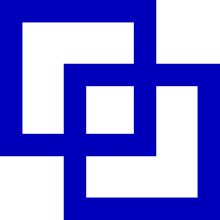Western square dance
Western Square Dance (also called Modern American Square Dance or Modern Western Square Dance ) is - in contrast to Traditional Square Dance - the modern type of Square Dance .
principle
Western square dance is led by a caller . A square consists of four pairs that line up in the starting position in the form of a square (Engl. Square ). In chanting to the music, the caller joins a series of different figures that are performed by the dancers in the square. There is no limit to the number of squares that can dance to a caller at the same time, and each square dances independently from the others. The Square is for one tips a dance team. A tip usually consists of two dances (one pattern and one singing call each ) and is separated from the next tip by a pause, in which the dancers form new squares.
Dance programs
There are ten dance programs ( levels ) that build on each other. Each dance program completely includes the previous programs and contains new figures, formations and concepts that have a considerable degree of difficulty in the advanced dance programs. The programs are administered and occasionally adjusted by Callerlab , an international association of square dance callers in the USA. In the case of dance events ( specials , jamborees , etc.), the program offered is usually determined in advance and announced accordingly. The dancers can be sure that the dance program on offer includes the same figures around the world.
| Abbreviation | Program name | scope |
|---|---|---|
| B. | basic | 51 groups of figures |
| MS | mainstream | 17 groups of figures |
| + | plus | 30 figures |
| A1 | Advanced 1 | 47 figures |
| A2 | Advanced 2 | 36 characters and concepts |
| C1 | Challenge 1 | 75 characters and concepts |
| C2 | Challenge 2 | 74 characters and concepts |
| C3a | Challenge 3A | 78 characters and concepts |
| C3b | Challenge 3B | 73 characters and concepts |
| C4 | Challenge 4 | approx. 700 characters and concepts |
(Status May 2013)
The number of figures specified for the dance programs can differ if not whole groups of figures (which combine similar figures), but the individual figures are counted. All programs include all of the characters and concepts of the lower programs. The programs C3b and C4 are not subject to standardization by Callerlab.
In October 2006 the “Basic” program, which had been abolished as a stand-alone program in 2000, was officially resumed by Callerlab. In Germany, in contrast to other countries such as Sweden, this program is rarely offered.
Variants (examples)
The following variants are not standardized by Callerlab, but are occasionally offered at club evenings or events:
- Hot hash is very fast mainstream. The challenge lies in the high speed. Usually characters that only serve to gain time are not announced.
- Fun Squares - The focus here is not on exact dancing, but on having fun. Here it happens, for example, that couples change square on a so-called scatter promenade. A common fun square variant is the hexagon formation; The starting position is not a square with four, but a hexagon with six dance couples.
Courses, competitions
The necessary figures and steps can organize to square dance clubs be learned by almost anyone who has an approximately nine-month course ( class ), which usually starts in the fall and (in early summer with a graduation ceremony graduation ends).
There have been no competitions in square dance since the 1950s . It is danced all over the world "for the fun of joy".
Fashion
In Germany, traditional square dance clothing is worn at events, demonstrations and often when visiting foreign clubs. When attending your own club evening, the clothing customs are subject to a north-south gradient: while it is common almost everywhere in southern Germany to appear in square dance clothes for every club evening, there are significantly more clubs further north that wear street clothes for the club evening will be carried. There is a similar gradient in dance programs: the higher the dance program, the more the dancers tend to wear less formal attire. Occasionally a certain club evening in the month is designated as a "monthly dance", to which the dancers should appear in dance clothes.
Traditional square dance clothing includes:
- The gentlemen usually wear a western shirt with long sleeves, a braided collar cord ( bolo tie ) or a scarf, collar corners for decoration, a belt with a decorative buckle and occasionally a small towel on the belt.
- The women mostly wear a blouse and a skirt with a belt, including a petticoat and so-called "pettipants" (lace panties).
There is seldom uniformity in clothing, but couples often appear in a partner look. In contrast to the custom in Europe, for example in the USA a meeting of square dancers to dance without appropriate dance clothes is hardly conceivable.
Web links
- Dosado.com - An informative site about square dancing
- EAASDC - The website of the European Association of American Square Dance Clubs (German, English)
- Callerlab - The website of the American Callers Association

